
The history of Armenia covers the topics related to the history of the Republic of Armenia, as well as the Armenian people, the Armenian language, and the regions of Eurasia historically and geographically considered Armenian.
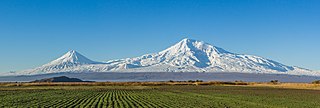
Ararat is a province (marz) of Armenia. Its capital and largest city is the town of Artashat.
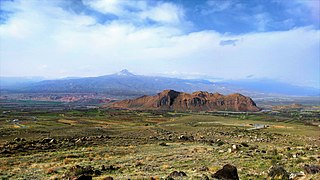
Armavir, is a province (marz) in the western part of Armenia. Located in the Ararat plain dominated by Mount Ararat from the south and Mount Aragats from the north, the province's capital is the town of Armavir while the largest city is Vagharshapat (Etchmiadzin). The province shares a 72 km (45 mi)-long border with Turkey to the south and west.

Mannaea was an ancient kingdom located in northwestern Iran, south of Lake Urmia, around the 10th to 7th centuries BCE. It neighbored Assyria and Urartu, as well as other small buffer states between the two, such as Musasir and Zikirta.

Sophene was a province of the ancient kingdom of Armenia, located in the south-west of the kingdom, and of the Roman Empire. The region lies in what is now southeastern Turkey.
Hayasa-Azzi or Azzi-Hayasa was a Late Bronze Age confederation in the Armenian Highlands and/or Pontic region of Asia Minor. The Hayasa-Azzi confederation was in conflict with the Hittite Empire in the 14th century BC, leading up to the collapse of Hatti around 1190 BC. It has long been thought that Hayasa-Azzi may have played a significant role in the ethnogenesis of Armenians.
Rusa I was a King of Urartu. He succeeded his father, king Sarduri II. His name is sometimes transliterated as Rusas or Rusha. He was known to Assyrians as Ursa and possibly Urzana. His birth name may have been Uedipri.
Nairi was the Akkadian name for a region inhabited by a particular group of tribal principalities in the Armenian Highlands, approximately spanning the area between modern Diyarbakır and Lake Van and the region west of Lake Urmia. Nairi has sometimes been equated with Nihriya, known from Mesopotamian, Hittite, and Urartian sources. However, its co-occurrence with Nihriya within a single text may argue against this.

Muṣaṣir, in Urartian Ardini was an ancient city of Urartu, attested in Assyrian sources of the 9th and 8th centuries BC.
The origin of the Armenians is a topic concerned with the emergence of the Armenian people and the country called Armenia. The earliest universally accepted reference to the people and the country dates back to the 6th century BC Behistun Inscription, followed by several Greek fragments and books. The earliest known reference to a geopolitical entity where Armenians originated from is dated to the 13th century BC as Uruatri in Old Assyrian. Historians and Armenologists have speculated about the earlier origin of the Armenian people, but no consensus has been achieved as of yet. Genetic studies show that Armenian people are indigenous to historical Armenia, showing little to no signs of admixture since around the 13th century BC.
The name Armenia entered English via Latin, from Ancient Greek Ἀρμενία.
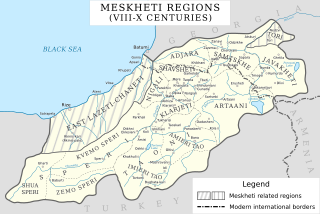
Tao is a historical Georgian district and part of historic Tao-Klarjeti region, today part of the Eastern Anatolia region of Turkey. Its name derives from the ancient proto-Georgian inhabitants of this area, known as Taochi.
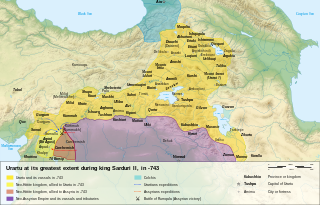
Sarduri II was a King of Urartu, succeeding his father Argishti I to the throne. The Urartian Kingdom was at its peak during his reign, campaigning successfully against several neighbouring powers, including Assyria.
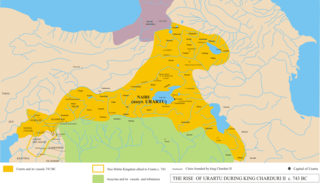
The Urartu–Assyria War was a conflict between the Kingdom of Urartu and the Neo-Assyrian Empire. The war began around 714 BC, with the invasion of Urartu by the Assyrian King Sargon II. Sargon led multiple offensives deep into Urartian territory, amassing numerous victories in the war. Following his death, however, Urartian Kings Argishti II and Rusa II launched many successful counterattacks, reclaiming Urartu's lost territory and gaining some from Assyria. However, their successors suffered multiple major defeats, resulting in Urartu becoming an Assyrian client state.

Urartu was an Iron Age kingdom centered around the Armenian highlands between Lake Van, Lake Urmia, and Lake Sevan. The territory of the ancient kingdom of Urartu extended over the modern frontiers of Turkey, Iran, Iraq, and the Republic of Armenia. Its kings left behind cuneiform inscriptions in the Urartian language, a member of the Hurro-Urartian language family. These languages might have been related to Northeast Caucasian languages. Following Armenian incursions into Urartu, Armenians "imposed their language" on Urartians and became the aristocratic class. The Urartians later "were probably absorbed into the Armenian polity".

Argištiḫinili was a town in the ancient kingdom of Urartu, established during the expansion of the Urartians in the Transcaucasus under their king Argishti I, and named in his honour. It lasted between the 8th and 6th centuries BC. The ruins of the Argištiḫinili fortifications are 15 kilometres (9 mi) southwest of the present-day town of Armavir, Armenia, between the villages of Nor-Armavir and Armavir in the Armenian marz of Armavir. The town was founded on the left bank of the middle reaches of the Aras River. Over the centuries, the river channel has shifted to several kilometres south of the town.
Etiuni was the name of an early Iron Age tribal confederation in northern parts of Araxes River, roughly corresponding to the subsequent Ayrarat Province of the Kingdom of Armenia. Etiuni was frequently mentioned in the records of Urartian kings, who led numerous campaigns into Etiuni territory. It is very likely it was the "Etuna" or "Etina" which contributed to the fall of Urartu, according to Assyrian texts. Some scholars believe it had an Armenian-speaking population.
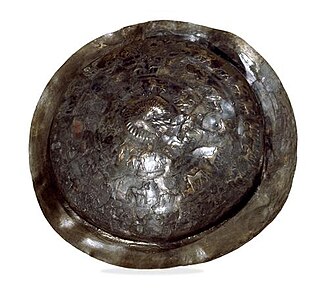
Erimena, according to tradition, was the twelfth king of Urartu and reigned from 625 to 605 BC. He was the successor of Sarduri III and father of Rusa III, who ruled Urartu from 610-590 B.C. Little is known about Erimena; his name was mentioned in an inscribed bronze shield found at Toprakkale by Hormuzd Rassam in 1880 that is now located in the British Museum. Erimena, according to a Babylonian chronicle, held an expedition in the mountainous region of Bit Hanounia, under the rule of Nabopolassar. He also suffered many attacks from the Babylonians which led to the decline of Urartu.

Paroyr Skayordi or Paroyr, son of Skayordi, was an Armenian king mentioned in the history of Movses Khorenatsi in the context of events of the 7th century BC. Khorenatsi describes him as a descendant of the Armenian patriarch Hayk who helped the Median king "Varbakes" defeat the Assyrian king "Sardanapalus" and received the crown of Armenia in return, becoming "the first to reign in Armenia." Different theories exist about the possible historical identity of Paroyr Skayordi, whose second name is sometimes interpreted as meaning "son of a Saka/Scythian" or "of Saka lineage." According to one view, he is identifiable with the Scythian king Partatua, who lived in the first half of the 7th century BC. Other scholars believe that he was the ruler of Arme-Shupria and allied with the Medes against Assyria around 612 BC. Others believe that he was the ruler of a Scythian land within the Etiuni confederation, which, according to one hypothesis, was the early polity of the Armenians.












